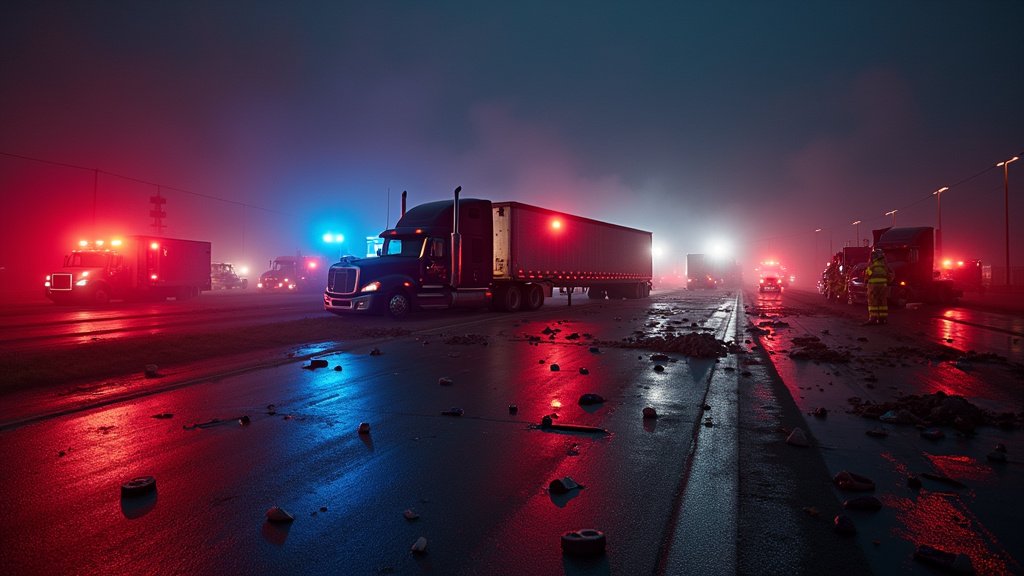A significant multi-vehicle collision involving two tractor-trailers and six passenger vehicles brought traffic to a standstill on Interstate 20 in East Texas on Saturday afternoon, injuring 17 people. The incident occurred near Lindale, approximately 90 miles east of Dallas, around 4 p.m., prompting a lengthy closure of the westbound lanes as emergency crews managed the scene and cleaned up spilled fuel.
Lindale Fire Chief Jeremy LaRue confirmed that all reported injuries were non-life-threatening. First responders transported the injured individuals to area hospitals for treatment. The exact cause of the massive pileup remains under investigation by the Texas Department of Public Safety (DPS), with authorities working to piece together the sequence of events that led to the widespread disruption.
Collision Details and Traffic Halt
The catastrophic crash involved a complex interplay between large commercial trucks and multiple passenger cars, creating a hazardous situation that required extensive response from multiple agencies. The impact of the collision was severe enough to necessitate the complete closure of the westbound lanes of I-20. This closure lasted for more than two hours as crews worked diligently to clear debris and manage the slick conditions caused by spilled oil and diesel fuel from the damaged tractor-trailers.
Motorists attempting to travel westbound were diverted, leading to significant traffic backups stretching for miles. Authorities advised drivers to seek alternate routes and avoid the area to allow emergency personnel unimpeded access to the crash site. The disruption highlighted the critical role of Interstate 20 as a major artery for commerce and travel across Texas, and the considerable impact when it is compromised.
The Dangers of Interstate 20
This recent event underscores a persistent concern regarding safety on Interstate 20, a highway frequently cited in studies as one of the most dangerous in the United States. Known for its high speed limits, especially in West Texas where they can reach 80 mph, and heavy traffic density, I-20 presents numerous challenges for drivers. A 2021 study by The Zebra ranked I-20 as the second-deadliest highway in the U.S., citing a high rate of fatal crashes per mile.
Statistics from the Federal Motor Carrier Safety Administration (FMCSA) also indicate that Interstate 20 is a high-risk corridor for commercial truck drivers, often linked to weather-related incidents. Factors such as speeding, driver fatigue, distracted driving, and the sheer size and weight of commercial vehicles contribute to the elevated risk profile of this route. The presence of multiple work zones, coupled with ongoing infrastructure improvements, can further exacerbate traffic conditions and accident potential.
Ongoing Investigation and Community Impact
As the Texas Department of Public Safety continues its investigation into the precise causes of Saturday’s collision, the focus remains on understanding contributing factors such as speed, adherence to traffic laws, and potential mechanical failures. The findings from this investigation will be crucial in determining accountability and implementing measures to prevent similar incidents in the future.
News of the crash quickly became a trending topic across local and national platforms, drawing attention to the daily risks faced by travelers on major highways. The incident serves as a stark reminder for drivers, particularly those operating large commercial vehicles, to exercise extreme caution and prioritize safety on the road. The East Texas community, accustomed to the flow of traffic along I-20, faced significant disruption, and the long-term effects on those injured will require ongoing attention and support.
This latest accident on Interstate 20 is a significant piece of Texas news, reinforcing the need for continuous efforts in road safety education and enforcement to protect lives and prevent future tragedies on the state’s vital transportation networks. The prompt response from local fire departments, EMS, and law enforcement was critical in managing the immediate aftermath and ensuring the safety of the public.






